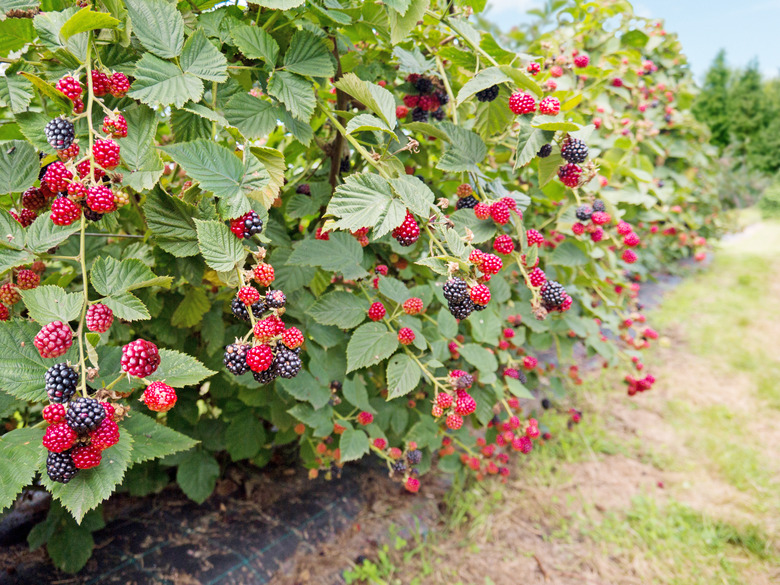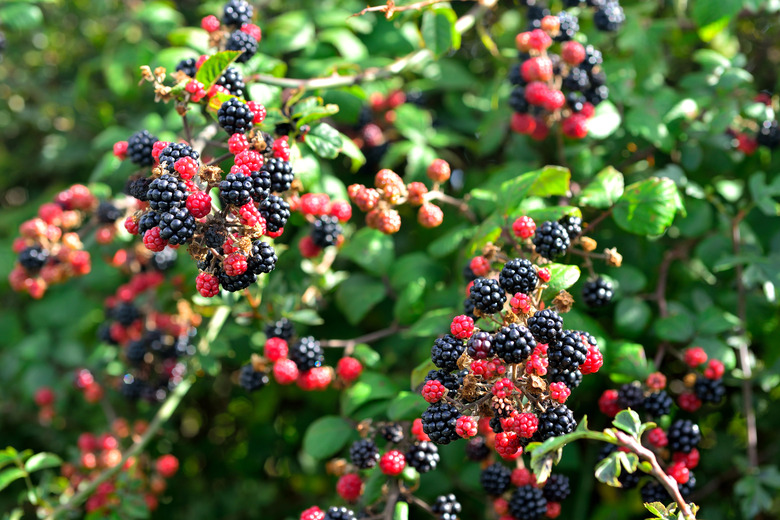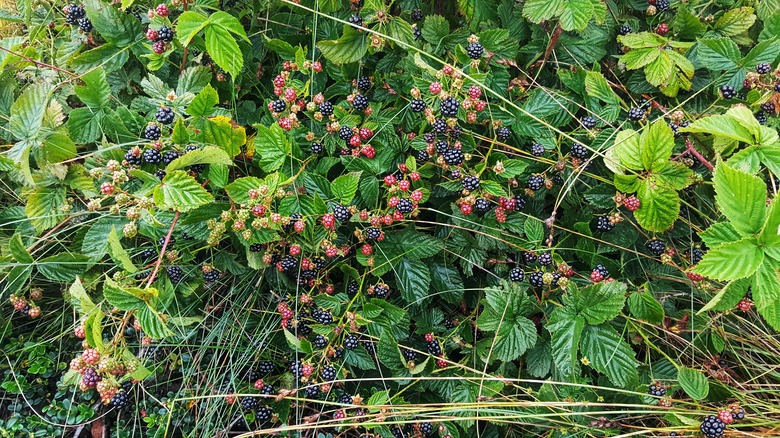How To Grow Blackberries
We may receive a commission on purchases made from links.
- Best uses for blackberries
- How to grow blackberries
- In what zone do blackberries grow best?
- When should you plant blackberries?
- Soil, sunlight and water recommendations for blackberries
- How to winterize blackberries
- How to harvest blackberries
- Common pests and other problems for blackberries
- Common diseases for blackberries
Nothing says summer quite like plucking a sun-warmed blackberry (Rubus spp.) right off the bush and popping it into your mouth. In the past, doing so meant working around the blackberry bush's sharp thorns. Today, however, many thornless blackberry varieties are available, making the plants easier to maintain and safer for children and pets.
Blackberry bushes are perennials, so you can plant them once and expect a healthy berry crop year after year. As a North American native, blackberies are fruits that most American gardeners find easy to grow and care for. They do require quite a bit of pruning at the end of each season, however. You can choose an erect plant variety capable of supporting itself or grow trailing blackberries on a trellis.
Best Uses for Blackberries
Best Uses for Blackberries
There's no doubt that gardeners grow blackberries to eat. Sweet and tangy, blackberries boast a delightful flavor when they are eaten raw or cooked into jams and jellies. You can also freeze blackberries or use them in fruit salads, pies and other dishes.
Although primarily grown as food, blackberries can do double duty when planted as a hedge or natural barrier. The thorny varieties work especially well for this, keeping unwanted wildlife and other visitors at bay.
How to Grow Blackberries
How to Grow Blackberries
- Common Name: Blackberry
- Botanical Name: Rubus spp.
- When to Plant: Plant after the last frost in spring
- USDA Zones: 3-10, depending on species and cultivar
- Sun Exposure: Full sun
- Soil Type: Rich, well-draining soil
- When it's in Trouble: Skeletonized leaves, discolored leaves, wormy fruit
- When it's Thriving: Deep green leaves, fruiting canes, overall vigor
Starting Blackberries From Seed
When starting blackberries from seed, it's generally best to start them indoors a few weeks before the last expected frost. Begin by soaking the seeds in water for 24 hours. After soaking, sow them in a loose potting soil or seed-starting mix along with some compost. Press the seeds no more than 1/16 inch in the soil.
Keep the soil moist but not wet until your seedlings sprout. When they do, start taking them outside for a few hours a day to acclimate them to the outdoors. When the danger of frost has passed, transplant your blackberry seedlings to the garden.
You can, of course, sow store-bought blackberry seeds, but you can also harvest your own seeds if desired from heirloom selections. Most hybrid cultivars don't set viable seed; if the seeds do germinate, they'll likely not come true to type. You'll need to harvest ripe fruit and then smoosh it. You can then use a strainer to help rinse the berry pulp away from the seeds. It may take several tries to get all the pulp off them.
Place your seeds in a shallow pan to dry. When they have, fill a plastic bag with damp peat moss and drop your blackberry seeds into it. You can store the seed bag in your refrigerator for three to five months. After that, the seeds may germinate.
Starting Blackberries From a Seedling
You can sprout your own blackberry seedlings, purchase seedlings at your local garden center or acquire bare-root blackberry plants. Soak bare-root plants before planting. It's not necessary to soak seedlings.
Work the soil deeply enough that all of your blackberry plant seedlings will fit into the ground with all of their roots completely covered. Mix in some compost if desired to enrich your soil. When digging, make your planting trenches about 2 feet wide. When you complete your trenches, deposit your plants in them, spacing them 4 feet apart. Try to align seedlings so that the soil level is the same as it was in their original pots.
Blackberry plants don't root deeply, but it's still important to make sure you completely cover all of the roots with soil. Water your new seedlings after planting.
In What Zone Do Blackberries Grow Best?
In What Zone Do Blackberries Grow Best?
The blackberry is a perennial plant grown in USDA plant hardiness zones 3 through 10. Your local climate is more likely to affect which type of blackberries you grow rather than whether or not you can grow them. Your local garden center or cooperative extension service will know which cultivars grow best in your area, which makes buying your plants locally a good idea when you can.
When Should You Plant Blackberries?
When Should You Plant Blackberries?
Although you can plant them late in the fall, it's generally best to plant blackberries in the spring after the danger of frost passes. Gardeners in the Northeast and Midwest in particular should avoid fall plantings. Spring planting gives the blackberries time to establish themselves so that they're healthy enough to overwinter well. Once planted, blackberry bushes will come back every spring.
Soil, Sunlight and Water Recommendations for Blackberries
Soil, Sunlight and Water Recommendations for Blackberries
Blackberries like bright, sunny spots where the soil pH is a slightly acidic 6.5 to 6.8. If possible, avoid planting blackberries in soil that recently housed strawberries, potatoes, tomatoes or eggplants. These fruits and vegetables may leave behind fungal or bacterial pathogens in the soil that could negatively affect your blackberry bush.
Keep your blackberry bushes well away from wild blackberry bushes in your area as well. Wild berry bushes have no one to tend to them and may develop diseases or infestations that could spread to your plants. If you've chosen a trailing blackberry variety, install sturdy trellises and train your plants onto them.
Blackberries need about an inch of water per week during the growing season. They don't take kindly to drought, particularly when they're fruiting. Monitor rainfall closely and make sure your plants get the water they need.
To preserve water and keep weeds down, apply a 3- to 4-inch layer of mulch around your blackberries. Blackberries like well-mulched soil but not weeds, so weed often and add more mulch throughout the growing season if yours starts to thin.
Being native to North America, most blackberry bushes and vines do just fine by themselves. You can have more vigorous plants that produce more berries, however, if you fertilize your plants with a 10-10-10 fertilizer in the spring and then again in July or August, if this is indicated by soil-test results.
How to Winterize Blackberries
How to Winterize Blackberries
As perennials, blackberry plants need no special attention in the winter. They will die back each winter and renew themselves every spring without assistance. As long as you choose a variety that is hardy in your area, you won't need to give blackberries any special winter attention.
How to Harvest Blackberries
How to Harvest Blackberries
Your blackberries are ready for harvest when they're dark in color, dull and quite plump. Picking them is easy — ripe berries will practically leap off the plant at your touch, requiring no twisting, pulling or other encouragement. Once your berries are ready, you can keep picking them every day or so for three to four weeks.
Blackberries are delicate and don't last long after picking, You'll need to eat your blackberries two or three days after harvest or freeze them. You can also make blackberry jam and can it for a long shelf life.
It is worthy of note that blackberry stems, called canes, produce fruit in their second year rather than their first. As such, your blackberry plants may produce little to no fruit during their first year or two. Don't get discouraged if your plants don't produce well at first. You'll have more berries than you know what to do with soon enough.
Once you've picked your blackberries, wait until the cane you picked dies back. When it has, prune it off at ground level. After pruning, take the light-green new canes that your plant produces and gently attach them to your trellis if applicable. Make sure you remove only old canes that you've already harvested when pruning. Removing new canes will prevent your plant from setting fruit, however, so leave new growth alone.
Common Pests and Other Problems for Blackberries
Common Pests and Other Problems for Blackberries
If you're growing blackberries, prepare to share. Everyone loves blackberries, from deer to birds to the neighbor children. Plant plenty of bushes so you have enough fruit to go around. You can protect your crop by covering the blackberry plant with netting if you're not feeling particularly generous. Do so after pollination rather than before. You'll know its time when you see tiny immature berries start to form on your plants in midsummer.
Blackberries are also subject to the usual thrips, aphids and leafhoppers frequently found in backyard gardens. In addition, blackberry growers must be on the lookout for cane borers and fruitworms (blackberry beetle).
Cane borers live in the blackberry canes, causing them to bulge out. Small piles of sawdust around the plant also indicate cane borers. Fruitworms are visible inside picked blackberries and leave their eggs on the plants' blossoms.
You can control all of these insect pests by applying a broad spectrum insect killer that's safe to use on fruiting crops. If you prefer an organic approach, try insecticidal soap instead. You can control aphids easily by shooting them off plants with a stream of water, but cane borers and fruitworms may prove to be more persistent pests.
Common Diseases for Blackberries
Common Diseases for Blackberries
Blackberry plants sometimes contract a disease called purple blotch. When they do, small green sores start to appear near the bottom of the plant, working their way up as the disease progresses. Eventually, the sores turn from green to brown or red. To prevent purple blotch, keep your blackberry plants well away from their wild blackberry bush cousins, if possible.
Cane canker may also occur in blackberries. In this disease, red and brown sores appear on blackberry buds. Cane canker most often finds its way into a wounded plant, so take care not to mow or trim too close to your plants and be careful when working in the garden. Choose blackberry varieties that are resistant to the disease if it's known to be an issue in your area and avoid offering plants too much nitrogen.
Like most plants in your garden, blackberries can fall prey to rots, mildews and molds. Fortunately, good gardening practices can prevent these issues most of the time. Space your blackberry plants far enough apart to allow for adequate air circulation, irrigate plant roots rather than leaves and stay out of the garden when it's wet.
Never allow fallen fruit, leaves or other debris to stay in your garden for long before raking it up. Remove or treat diseased plants promptly and always sterilize your pruning equipment when moving from one plant to the next. If you know disease is present, increase your sterilization practices and clean your pruning shears after each cut.
References
- Nourse: Introduction to Growing Blackberries
- Gardeners' World: How to Grow Blackberries
- NC State Extension: Blackberries for the Home Garden
- GardenTech: How to Plant, Grow and Harvest Blackberries and Raspberries
- The Old Farmer's Almanac: Growing Blackberries
- Urban Farmer: From Seed to Harvest: A Guide to Growing Blackberries


